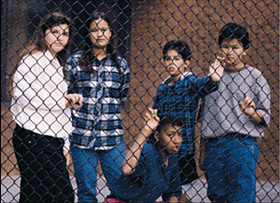 |
 |
 |
 Health & Beauty | January 2006 Health & Beauty | January 2006  
Police Fight Traffickers In Battle of Wits
 Jorge Alejandro Medellín - El Universal Jorge Alejandro Medellín - El Universal


| | The traffickers don't care whose life they destroy. |
Every day the Mexico City airport is the scene of a colossal battle. But in this battle, the most powerful weapon is the imagination rather than guns.

While drug traffickers look for new and inventive ways to disguise their shipments, police use their own creativity to detect illicit substances, documents, and money slipping in or out of the country.

Opium gum has been stuffed inside ceramic figurines of Saint Anthony, large-denomination dollar bills were bundled in tin cans labeled as marinated chiles, and empanadas that were supposed to contain mole, tuna and pineapple were actually filled with bags of cocaine.

The Federal Security Secretariat oversees the operations of special police, drug task forces, and intelligence services at the Mexico City airport as well as 25 others across the country.

While the authorities are equipped with advanced technological tools, in many cases experience and "a sixth sense that sees beyond the obvious" are the most important utensils at their disposition.

As thousands of passengers flow through the airports each day, officers have only seconds to decide whether to ask someone to step aside for a more thorough revision of their luggage, shoes and clothing.

"We see something in the way they walk, their nervousness, something illogical in their clothing," say the officers at one security checkpoint. Turtlenecks and bulky jackets in the summer may indicate a person with something to hide.

Federal police agents admit that many do get through undetected because of the volume of passengers and because traffickers are always finding better ways to hide their bounty. But just as there are a thousand ways to hide, there are a thousand ways to detect, they say.

Federal police statistics for 2005 report 79 separate incidents where criminal shipments were intercepted.

Fifty-three people were arrested in the nation´s airports on drug-trafficking charges and police confiscated 2 tons of cocaine, 148 kilos of heroin and 327 grams of marijuana. Additionally they captured US$14 million being introduced or taken out of the country illegally.

An internal police report on airports in 2005 said drug trafficking continues to follow "logical" routes. Drugs usually come from Central and South America, and the airports that get most of them are Mexico City, Tijuana and Mexicali. Guadalajara and Cancún airports are hotspots for illegal activity as well.

Inside the nation´s borders, drugs tend to move through the states of Michoacán, Guanajuanto and Jalisco as they make their way north.

The trafficking of currencies, mainly U.S. dollars, is usually concentrated in the airports of Mexico City, Toluca and Cancún, police said.

Police say the battle against the trafficking of drugs, weapons, and laundered money in the nation´s airports is "80 percent experience and intuition. The remaining 20 percent is with technological tools." | 
 | |
 |



